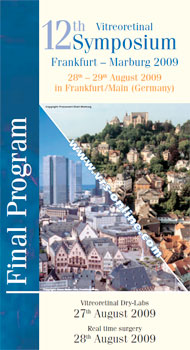12th Vitreoretinal Symposium Frankfurt – Marburg 2009
Scientific programm: Abstract
5th scientific session: The Upcoming
36. Testability, Results and Output Evaluation of a
Self-administered, PDA-based Visual Function
Questionnaire among Patients with Macular Disease
 Stephen. H. Sinclair1,Y. B. Unver2,
Stephen. H. Sinclair1,Y. B. Unver2,
G. A.Yavuz3, W. Li 2
(1Philadelphia; 2Istanbul; 3Bolu)
Purpose: VFQ’s, while proving useful insight to vision problems affecting daily activities, have not been widely accepted because of the expense and time for professional administration and paper recording. A Visual Function Questionnaire (VFQ), derived from the NEI VFQ-25, was programmed as a self -administered VFQ on a PDA because of the high contrast screen, large font, ease of use, and tiered questioning. The aim of this study was to evaluate its testability in a retinal practice and compare the results with the administered NEI VFQ-25.
Methods: 130 consecutive patients with an assortment of macular disease in a retinal outpatient setting were tested excluding those who did not understand written or spoken English or had recently undergone intraocular surgery or laser. At the first patient visit, the NEI-VFQ 25 was administered and recorded on a paper form by trained ophthalmic personnel. At the second visit the PDA VFQ was administered, providing high-plus reading spectacles, if the patient could not read the questions with their habitual correction. The 24 questions in each of the questionnaires were grouped according to tasks, calculating the averages of the graded responses for the questions comprising the group. Bland and Altman methods were utilized to calculate VFQ comparisons.
Results: Eighty percent of the retina patients performed the PDA VFQ without difficulty using their own reading spectacles. In this group the best corrected visual acuity (BCVA) in the better seeing eye varied between 20/50 to 20/200. An additional 10% could complete the PDA based VFQ with the aid of high-plus reading spectacles. In these cases, the BCVA in the better seeing eye ranged between 20/200 to 20/64. The remainder 10% required a family member to complete the questionnaire. The mean duration of the test with the PDA VFQ was 2.5 minutes compared with the NEI VFQ-25 requirement of 8 minutes (p ≤0.0001). Among the 17 task groups derived from the questions, Bland and Altman analysis demonstrated no differences in any of the groups between the NEI VFQ-25 and the PDA based VFQ.(P<0.001).
Conclusion: The newly devised PDA questionnaire appears to offer an inexpensive, easily performed method to elicit VFQ information from patients with a wide range of vision abnormalities. Furthermore, the equipment offers an additional benefit in the capability to upload results for EMR and database management and to download printable outcomes that can be shared with the patient and family to assist initiation of low vision rehabilitation along with planned treatment
Copyright © VRS-online, 1999-.
All rights reserved. Impressum, rechtliche Hinweise
HTML & Webdesign: SPALLEK.COM
